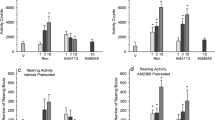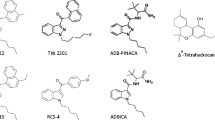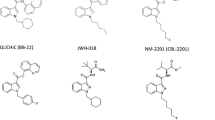Abstract
Rationale
Lower lip retraction (LLR) in rats has been described as a distinctive effect of 5-HT1A agonists. In the course of evaluating behavioral effects of cannabinoid agonists in rats, LLR effects were evident following injection of several cannabinoid agonists.
Objectives
To pharmacologically characterize cannabinoid-induced LLR in rats.
Methods
Lower lip retraction was scored using a 3-point scale for up to 6 h after injection of the cannabinoid agonists Δ9-tetrahydrocannabinol (Δ9-THC, 1–10 mg/kg), AM7499 (0.01–1.0 mg/kg), or AM2389 (0.003–0.1 mg/kg), or, for comparison, the 5-HT1A agonist 8-OH-DPAT (0.01–0.3 mg/kg). Next, antagonist effects of rimonabant (1–10 mg/kg) and WAY100635 (0.3 mg/kg) on LLR produced by cannabinoid or 5-HT1A agonists were evaluated. Lastly, effects of 8-OH-DPAT were determined following pretreatment with AM2389 (0.003–0.01 mg/kg) or Δ9-THC (1 mg/kg).
Results
All three cannabinoid agonists produced LLR. Effects of AM2389 were attenuated by both rimonabant and WAY100635 whereas effects of 8-OH-DPAT were antagonized by WAY 100635 but not by rimonabant. Pretreatment with 1 mg/kg Δ9-THC or 0.01 mg/kg AM2389 shifted the 8-OH-DPAT dose-effect function for LLR to the left and isobolographic analysis of the data indicates CB1 and 5-HT1A interactions can be supraadditive.
Conclusions
Cannabinoid agonists produce LLR in rats, an effect heretofore ascribed only to activity at 5-HT1A receptors, via CB1 receptor-mediated actions. Co-administration of a cannabinoid agonist and the 5-HT1A agonist 8-OH-DPAT results in a synergistic effect on LLR.






Similar content being viewed by others
References
Ahmad Y, Laurent E, Maillet P, Talab A, Teste JF, Dokhan R, Tran G, Ollivier R (1997) New benzocycloalkylpiperazines, potent and selective 5-HT1A receptor ligands. J Med Chem 40:952–960
Assié MB, Bardin L, Auclair AL, Carilla-Durand E, Depoortere R, Koek W, Kleven MS, Colpaert F, Vacher B, Newman-Tancredi A (2010) F15599, a highly selective post-synaptic 5-HT(1A) receptor agonist: in-vivo profile in behavioural models of antidepressant and serotonergic activity. Int J Neuropsychopharmacol 13:1285–1298
Bambico FR, Cassano T, Dominguez-Lopez S, Katz N, Walker CD, Piomelli D, Gobbi G (2010) Genetic deletion of fatty acid amide hydrolase alters emotional behavior and serotonergic transmission in the dorsal raphe, prefrontal cortex, and hippocampus. Neuropsychopharmacology 35:2083–2100
Berendsen HH, Jenck F, Broekkamp CL (1989) Selective activation of 5HT1A receptors induces lower lip retraction in the rat. Pharmacol Biochem Behav 33:821–827
Carhart-Harris RL, Nutt DJ (2017) Serotonin and brain function: a tale of two receptors. J Psychopharmacol 31:1091–1120
Cheer JF, Cadogan AK, Marsden CA, Fone KC, Kendall DA (1999) Modification of 5-HT2 receptor mediated behaviour in the rat by oleamide and the role of cannabinoid receptors. Neuropharmacology 38:533–541
Chopda GR, Vemuri K, Sharma R, Thakur GA, Makriyannis A, Paronis CA (2013) Diuretic effects of cannabinoid agonists in mice. Eur J Pharmacol 721:64–69
De Petrocellis L, Bisogno T, Davis JB, Pertwee RG, Di MV (2000) Overlap between the ligand recognition properties of the anandamide transporter and the VR1 vanilloid receptor: inhibitors of anandamide uptake with negligible capsaicin-like activity. FEBS Lett 483:52–56
Egashira N, Matsuda T, Koushi E, Mishima K, Iwasaki K, Shoyama Y, Fujiwara M (2006) Involvement of 5-hydroxytryptamine1A receptors in Delta9-tetrahydrocannabinol-induced catalepsy-like immobilization in mice. Eur J Pharmacol 550:117–122
Egashira N, Matsuda T, Koushi E, Higashihara F, Mishima K, Chidori S, Hasebe N, Iwasaki K, Nishimura R, Oishi R, Fujiwara M (2008) Delta(9)-tetrahydrocannabinol prolongs the immobility time in the mouse forced swim test: involvement of cannabinoid CB(1) receptor and serotonergic system. Eur J Pharmacol 589:117–121
Elmore JS, Baumann MH (2018) Repeated exposure to the “Spice” cannabinoid JWH-018 induces tolerance and enhances responsiveness to 5-HT1A receptor stimulation in male rats. Front Psychiatry 9:55. https://doi.org/10.3389/fpsyt.2018.00055
Haj-Dahmane S, Shen RY (2011) Modulation of the serotonin system by endocannabinoid signaling. Neuropharmacology 61:414–420
Häring M, Marsicano G, Lutz B, Monory K (2007) Identification of the cannabinoid receptor type 1 in serotonergic cells of raphe nuclei in mice. Neuroscience 146:1212–1219
Häring M, Enk V, Aparisi Rey A, Loch S, Ruiz de Azua I, Weber T, Bartsch D, Monory K, Lutz B (2015) Cannabinoid type-1 receptor signaling in central serotonergic neurons regulates anxiety-like behavior and sociability. Front Behav Neurosci 9:235. https://doi.org/10.3389/fnbeh.2015.00235 eCollection 02015
Herkenham M, Lynn AB, Johnson MR, Melvin LS, de Costa BR, Rice KC (1991) Characterization and localization of cannabinoid receptors in rat brain: a quantitative in vitro autoradiographic study. J Neurosci 11:563–583
Hill MN, Sun JC, Tse MTL, Gorzalka BB (2006) Altered responsiveness of serotinin receptor subtypes following long-term cannabinoid treatment. Int J Neuropsychopharmacol 9:277–286
Jacobs BL, Azmitia EC (1992) Structure and function of the brain serotonin system. Physiol Rev 72:165–229
Jastrzebska-Wiesek M, Partyka A, Rychtyk J, Sniecikowska J, Kolaczkowski M, Wesolowska A, Varney MA, Newman-Tancredi A (2018) Activity of serotonin 5-HT1A receptor biased agonists in rat: anxiolytic and antidepressant-like properties. ACS Chem Neurosci 9:1040–1050. https://doi.org/10.1021/acschemneuro.7b00443
Jones CA, Johnston LC, Jackson MJ, Smith LA, van Scharrenburg G, Rose S, Jenner PG, McCreary AC (2010) An in vivo pharmacological evaluation of pardoprunox (SLV308) - a novel combined dopamine D2/D3 receptor partial agonist and 5-HT1A receptor agonist with efficacy in experimental models of Parkinsons's disease. Eur Neuropsychopharmacol 20:582–593
Kimmel HL, Tallarida RJ, Holtzman SG (1997) Synergism between buprenorphine and cocaine on the rotational behavior of the nigrally-lesioned rat. Psychopharmacology 133:372–377
Kleven M, Ybema C, Carilla E, Hamon M, Koek W (1995) Modification of behavioral effects of 8-hydroxy-2-(di-n-propylamino) tetralin following chronic ethanol consumption in the rat: evidence for the involvement of 5-HT1A receptors in ethanol dependence. Eur J Pharmacol 281:219–228
Koek W, Patoiseau J-F, Assie MB, Cosi C, Kleven M, Dupont-Passelaigue E, Carilla-Durand E, Palmier C, Valentin J-P, John G, Pauwels PJ, Tarayre JP, Colpaert FC (1998) F 11440, a potent, selective, high efficacy 5-HT1A receptor agonist with marked anxiolytic and antidepressant potential. J Pharm Exp Ther 287:266–283
Koek W, Assié MB, Zernig G, France CP (2000) In vivo estimates of efficacy at 5-HT 1A receptors: effects of EEDQ on the ability of agonists to produce lower-lip retraction in rats. Psychopharmacology 149:377–387
Kulkarni S, Nikas SP, Sharma R, Jiang S, Paronis CA, Leonard MZ, Zhang B, Honrao C, Mallipeddi S, Raghav JG, Benchama O, Järbe TU, Bergman J, Makriyannis A (2016) Novel C-ring-hydroxy-substituted controlled deactivation cannabinergic analogues. J Med Chem 59:6903–6919
Li J-X, Rice KC, France CP (2007) Behavioral effects of dipropyltryptamine in rats: evidence for 5HT1A and 5-HT2A agonist activity. Behav Pharmacol 18:283–288
Marco EM, Perez-Alverez L, Borcel E, Rubio M, Guaza C, Ambrosio E, File SE, Viveros MP (2004) Involvement of 5-HT1A receptors in behavioural effects of the cannabinoid receptor agonist CP 55,940 in male rats. Behav Pharmacol 15:21–27
Mato S, Aso E, Castro E, Martin M, Valverde O, Maldonado R, Pazos A (2007) CB1 knockout mice display impaired functionality of 5-HT1A and 5-HT2A/C receptors. J Neurochem 103:2111–2120
McMahon LR (2016) Enhanced discriminative stimulus effects of Δ9-THC in the presence of cannabidiol and 8-OH-DPAT in rhesus monkeys. Drug Alcohol Depend 165:87–93
Minervini V, Dahal S, France CP (2017) Behavioral characterization of κ opioid receptor agonist spiradoline and cannabinoid receptor agonist CP55940 mixtures in rats. J Pharm Exp Ther 360:280–287
Nakazi M, Bauer U, Nickel T, Kathmann M, Schlicker E (2000) Inhibition of serotonin release in the mouse brain via presynaptic cannabinoid CB1 receptors. Naunyn Schmiedeberg's Arch Pharmacol 361:19–24
Nikas SP, Alapafuja SO, Papanastasiou I, Paronis CA, Shukla VG, Papahatjis DP, Bowman AL, Halikhedkar A, Han X, Makriyannis A (2010) Novel 1′,1′-chain substituted Hexahydrocannabinols: 9β-Hydroxy-3-(1-hexyl-cyclobut-1-yl)-hexahydrocannabinol (AM2389) a highly potent cannabinoid receptor 1 (CB1) agonist. J Med Chem 53:6996–7010
Oakes MD, Law WJ, Clark T, Bamber BA, Komuniecki R (2017) Cannabinoids activate monoaminergic signaling to modulate key C. elegans behaviors. J Neurosci 37:2859–2869
Paronis CA, Thakur GA, Bajaj S, Nikas SP, Vemuri VK, Makriyannis A, Bergman J (2013) Diuretic effects of cannabinoids. J Pharm Exp Ther 344:8–14
Rawls SM, Cowan A, Tallarida RJ, Geller EB, Adler MW (2002) N-methyl-D-aspartate antagonists and WIN 55212-2 [4,5-dihydro-2-methyl-4(4-morpholinylmethyl)-1-(1-naphthalenyl-carbonyl)-6H-pyrrolo[3,2,1-i,j]quinolin-6-one], a cannabinoid agonist, interact to produce synergistic hypothermia. J Pharmacol Exp Ther 303:395–402
Rinaldi-Carmona M, Barth F, Héaulme M, Alonso R, Shire D, Congy C, Soubrié P, Brelière JC, Le Fur G (1995) Biochemical and pharmacological characterisation of SR141716A, the first potent and selective brain cannabinoid receptor antagonist. Life Sci 56:1941–1947
Solinas M, Tanda G, Wertheim C, Goldberg SR (2010) Dopaminergic augmentation of delta-9-tetrahyrdocannabinol (THC) discrimination: possible involvement of D2-induced formation of anadamide. Psychopharmacology 209:191–202
Stefanowicz J, Slowinski T, Wrobel MZ, Herold F, Gomolka AE, Wesolowska A, Jastrzebska-Wiesek M, Partyka A, Andres-Mach M, Czuczwar SJ, Luszczki JJ, Zagaja M, Siwek A, Nowak G, Zolnierek M, Baczek T, Ulenberg S, Belka M, Turlo J (2016) Synthesis and biological investigation of new equatorial (beta) stereoisomers of 3-aminotropane arylamides with atypical antipsychotic profile. Bioorg Med Chem 24:3994–4007
Sun Y, Alexander SPH, Garle MJ, Gibson CL, Hewitt K, Murphy SP, Kendall DA, Bennett AJ (2007) Cannabinoid activation of PPARα; a novel neuroprotective mechanism. Br J Pharmacol 152:734–743
Tallarida RJ (2006) An overview of drug combination analysis with isobolograms. J Pharmacol Exp Ther 319:1–7
Tallarida RJ (2012) Revisiting the isobole and related quantitative methods for assessing drug synergism. J Pharmacol Exp Ther 342:2–8
Tallarida RJ (2016) Drug combinations: tests and analysis with isoboles. Curr Protoc Pharmacol 72:9.19.1–9.19.19
Townsend D, Thayer SA, Brown DR (2002) Cannabinoids throw up a conundrum. Br J Pharmacol 137:575–577
Ward SJ, Lefever TW, Jackson C, Tallarida RJ, Walker EA (2008) Effects of a cannabinoid1 receptor antagonist and serotonin2C receptor agonist alone and in combination on motivation for palatable food: a dose-ratio analysis study in mice. J Pharm Exp Ther 325:567–576
Wiley JL, Lefever TW, Cortes RA, Marusich JA (2014) Cross-substitution of Δ9-tetrahydrocannabinol and JWH-018 in drug discrimination in rats. Pharmacol Biochem Behav 124:123–128
Zavitsanou K, Wang H, Dalton VS, Nguyen V (2010) Cannabinoid administration increases 5HT1A receptor binding and mRNA expression in the hippocampus of adult but not adolescent rats. Neuroscience 169:315–324
Acknowledgments
The authors thank Roger Spealman, Jack Bergman, Brian Kangas, and Fernando de Moura for comments on a previous version of the manuscript.
Funding
This work was supported by the National Institutes of Health [Grants DA023142, DA043700].
Author information
Authors and Affiliations
Corresponding author
Ethics declarations
Conflict of interest
The authors declare that they have no conflict of interest.
Additional information
Publisher’s Note
Springer Nature remains neutral with regard to jurisdictional claims in published maps and institutional affiliations.
Portions of this work were presented previously in: Chopda G, Anderson J, Nikas SP, Makriyannis A, Paronis CA. Cannabinoid CB1 and serotonin 5-HT1A agonists mediate lower lip retraction by independent mechanisms, at the 2012 FASEB meeting in San Diego, California; FASEB J (2012) 26:661.8
Rights and permissions
About this article
Cite this article
Chopda, G.R., Nikas, S.P., Sharma, R. et al. Cannabinoid-induced lower lip retraction in rats. Psychopharmacology 236, 1199–1206 (2019). https://doi.org/10.1007/s00213-018-5125-z
Received:
Accepted:
Published:
Issue Date:
DOI: https://doi.org/10.1007/s00213-018-5125-z




